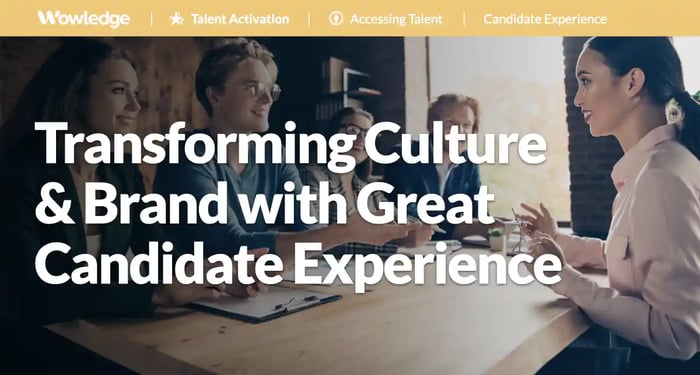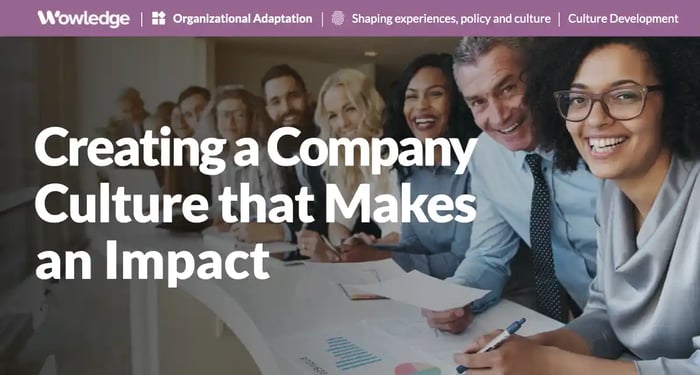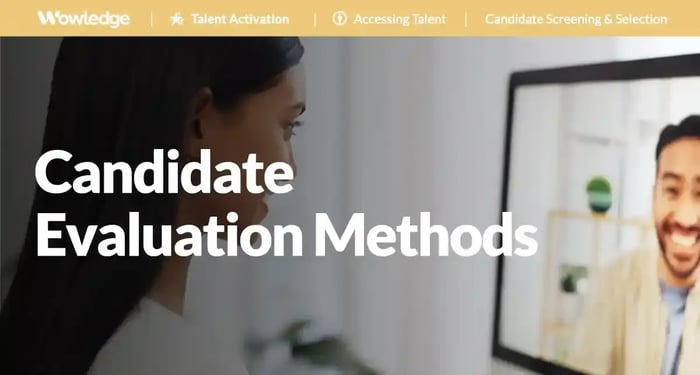Table of Contents
- Understanding candidate experience, company culture, and employer brand
- Reported challenges of candidates and employers
- How elements of the hiring process may negatively impact hiring and employer brand
- Supporting the communication of a positive culture and employment brand while hiring
- Making recruitment activity a consistent communicator and enhancer of company culture and employment brand
- Relevant Practices & Tools
- About Wowledge
The combination of an organization’s candidate experience, recruitment process, and associated technology can all provide candidates with a glimpse into a company's culture. Similarly, that candidate's experience can also impact the employer's brand. As a result, it is essential to understand how to protect or improve the employer brand through a streamlined, flexible, inclusive, welcoming, and clearly defined hiring process. Creating a great candidate experience drives positive candidate perceptions and a corporate employer brand reputation.
In the article "Eliminating Barriers to Hiring Great Talent” published on LinkedIn, I identified four categories of barriers to hiring great talent, including job qualifications, the recruitment process, technology, and biases and assumptions. It provided suggestions for overcoming them to increase access to top talent. Building on that, what follows is a revisiting of these barriers through the lens of company culture. More specifically, what do these barriers communicate to job applicants and current employees about the organizational culture?
What is critical to understand is that these barriers often create unintended consequences for an employer brand, as conclusions or assumptions are made about the culture based on the experiences of candidates seeking employment with the company. Examples of candidates having to endure multiple rounds of interviews, meeting with a wide range of managers and employees, or spending an hour or more completing an online application make them question if the effort is worth the potential for a job offer, and whether their experience is telling them that it will be challenging to get their work done once hired. As a result, building a great candidate experience can differentiate a company from its competitors in tight job markets.
Understanding candidate experience, company culture, and employer brand
What is candidate experience? It is the way a candidate feels about a company throughout the hiring process. Every interaction a candidate has with your company contributes to the perception a candidate develops of what it may be like to work at your company. A great candidate experience addresses every step of the process, from encountering job and career marketing content to applying, interviewing, and receiving feedback.
If candidates feel respected, welcomed, and comfortable throughout the hiring process, they will remain engaged and excited about the possibility of working for the organization. If candidates have negative experiences, they may abandon the hiring process by failing to complete the application, withdrawing it, declining an interview invitation, or rejecting a job offer.
As a result, a great candidate experience is crucial for attracting and hiring the desired talent, as well as to protect the employer brand. So, how does candidate experience impact an employer brand? What impression does it convey about the company's culture?
How are employer brand and company culture defined?. An employer brand is the reputation, perception, and value proposition that an organization communicates about itself as an employer to both potential and current employees. Company culture represents the values, attitudes, and practices that collectively define an organization's identity. Interestingly, candidates and employees can either reinforce or undermine an employer’s reputation based on their actions and reactions to experiences and interactions with the organization. But how?
Consider that candidates often discuss their experiences with a company’s hiring process with family and friends. At the same time, employees share their insights based on their experiences with leadership, colleagues, policies, benefits, compensation, and other aspects of the workplace. Additionally, candidates and employees will use social media platforms like Glassdoor and Indeed to share their experiences and post reviews of a company.
All of these can positively or negatively impact an employer's brand and its reputation as a workplace. The strategy of creating a great candidate experience is meant to make those impressions positive.
Reported challenges of candidates and employers
Candidates frequently report frustrations with their job search. More specifically, 61% of candidates report the online job search process as time-consuming and frustrating. In addition, reports have emerged that as they are applying for jobs, applicants often do not hear back and have to submit an average of 100-200+ applications to secure a single job offer. As a result, candidates are unemployed for an extended period, with 1.6 million Americans out of work for 27 weeks or longer.
Conversely, 67% of large employers report being unable to find talent as the reason for not filling roles, with a reported 8.1 million job openings in the United States. Additionally, employers are increasingly reporting dissatisfaction with the quality of job applicants.
Unfilled positions can affect employers by causing delays in meeting business objectives, reducing employee engagement and productivity, and increasing turnover rates. Additionally, candidates are frustrated because they are not getting hired.
So, what is at work here, and what are employers doing that may inadvertently sabotage their efforts to attract, assess, and hire top candidates for their open jobs effectively and efficiently?

How elements of the hiring process may negatively impact hiring and employer brand
When candidate experience is not well-tuned or considered a priority, a closer examination of key components and standard practices in the hiring process reveals clues as to how these can negatively impact an organization’s ability to hire talent, as well as its reputation as an employer.
Job qualifications
Often, hiring managers believe that boosting qualifications, quantifying experience, and requiring industry-specific knowledge will improve the quality of candidates and reduce the time needed for training. However, this frequently leads to a role being open for longer, further delaying business objectives, resulting in increased costs due to covering the vacancy in other ways, as well as negatively impacting employee morale. Three standard job requirements can become a barrier to a great candidate experience, quality hiring, and resulting employer brand:
Requiring a degree when it is not necessary for success in the role. For example: Requiring a college degree for an Administrative Assistant.
Resulting perceptions of the culture:
- May be seen as lacking awareness that some candidates are unable to pay for advanced education or do not have time to go to school due to family or other obligations.
- May be viewed as having a bias towards education with no recognition of the value that knowledge gained through hard work and direct experience can bring to a team.
- May consider it a non-inclusive working environment.
Requiring experience within a specific industry rather than considering candidates from related industries or evaluating whether industry knowledge is genuinely necessary for success in the role. Consider this: When ultimately successful employees first started in the industry, did they come equipped with knowledge of that industry? No, but they gained it on the job and became valuable contributors.
Resulting perceptions of the culture:
- May be seen as inflexible, rigid.
- May be viewed as having an association bias and not inclusive.
Requiring a certain number of years of experience, which is often a rough estimate and does not always reflect the depth or quality of a person’s skills or capabilities.
Resulting perceptions of the culture:
- May be seen as short-sighted, rigid, restrictive, and unaware that quantity does not always equate to quality of experience or depth of skills.
Recruitment process
Companies are setting increasingly challenging standards for candidates to meet, according to a recent report by Vox. This translates to endless rounds of interviews, various tests, and complex exercises and presentations that entail hours of work and prep. All of which makes the hiring process complicated, lengthy, and challenging for candidates. This lack of focus or concern for a great candidate experience often results in candidates withdrawing from the process, thereby compromising an organization’s ability to hire the talent it needs.
Multiple Interview Rounds that require repeated candidate meetings, visits, and rounds of interviews. In the same report by Vox as cited by SHRM, 36% of respondents said they had dropped out of the interview process because they had been asked to jump through hoops.
Resulting perceptions of the culture:
- Have difficulty making decisions. Candidates may wonder if it will be challenging to accomplish anything at the company.
- It may appear as if there is no consideration for the candidate’s time and the challenges multiple interviews pose, including the time of those employees involved in the interview process.
- Candidates may question the commitment to or availability of work-life balance.
- Lack of sensitivity to the time and schedule of the currently employed. Requiring a candidate to interview multiple times may necessitate taking time off from work, which could put their current job at risk.
- It may appear as if a candidate’s commitment to working at the company or their endurance is being tested. Candidates may further worry about their fit with a culture where employees feel they must decide between family and work.
Simultaneously interviewing external and internal candidates when there are qualified internal candidates available.
Resulting perceptions of the culture:
- A lack of commitment to the growth of existing employees.
- Poor or distrustful leadership, which impacts engagement and retention.
Candidates are not receiving feedback on the status of their candidacy for positions they apply for. According to the Monster Work Watch Report 2024, the top reason candidates withdrew their applications was poor communication. This has a profoundly negative impact on what should be a great candidate experience.
Resulting perceptions of the culture:
- A lack of respect and consideration towards people, especially if a candidate has been on-site to interview.
- Poor internal processes and controls.
Technology
“Qualified candidates are slipping through the cracks, while many companies are still struggling to hire,” says Raj Mukherjee, executive vice president at job site Indeed. While recruiting technologies boast advances and efficiencies, they can also convey an impersonal and negative image if not leveraged appropriately.
The ATS is not fully mobile-enabled despite almost 95% of global users accessing the internet via their smartphones. According to Appcast, around two-thirds of job applications are made from mobile devices. As a result, companies without a mobile-enabled ATS may lose candidates.
Resulting perceptions of the culture:
- Unresponsive to employees, lacking an awareness of how most people search for jobs.
- Questioning how technically advanced or aware the organization is.
Candidate screening technology that is over-relied upon. Korn Ferry estimates that applicant-tracking systems reject 75% of résumés, regardless of whether they are powered by AI or algorithm-based.
Resulting perceptions of the culture:
- A sense that the company does not value human judgment and focuses on the impersonal (automation) means rather quality relationship building.
- No consideration for or awareness that some candidates do not have access or easy access to tools or resources to assist them in preparing a resume or application materials that improve the ranking of their application through a resume screening tool.
- Not inclusive. Potentially excluding candidates who may not have access to job search coaching or resume writing assistance.
Biases and assumptions
All humans and their organizations have biases and make assumptions. However, using those that influence hiring decisions can communicate negative qualities about an organization’s culture and employer brand.
Screening "overqualified" candidates out because hiring managers are concerned that such candidates will not stay, want too much money, or may aspire for their (the manager’s) job.
Resulting perceptions of the culture:
- The company is biased and assumptive, where conclusions are drawn before having all the information.
- It is not committed to diversity or understanding the value that different experience levels can bring to a workplace.
- It has limited empathy or understanding that candidates may be at different stages of their lives with different aspirations, expectations, and preferences.
- Leadership is threatened by someone who may bring additional skills to the organization rather than welcoming the talent and seeing it as a gift.
- Leadership may be seen as wanting to surround themselves with “yes” or more compliant people versus those who may offer another perspective.
Eliminating laid-off candidates without further consideration. This is a common misconception about candidates who have been laid off. The biased thinking is that if they were valued as employees, the company would have found a way to keep them.
Resulting perceptions of the culture:
- A lack of compassion and humanity.
- Assumptive and drawing conclusions before having all the information.
- A lack of awareness that performance is typically not the driver of layoffs but instead cost savings.
Assuming that older candidates are less likely to contribute, will soon retire, are not open to learning new things, take longer to learn, and may not adapt to teams with younger workers.
Resulting perceptions of the culture:
- Biased and assumptive, where the organization “lumps” candidates into fixed categories instead of evaluating them as individuals with unique skills and experiences.
- Not inclusive, where candidates and employees are excluded based upon their characteristics and demographics versus their ability to contribute.

Supporting the communication of a positive culture and employment brand while hiring
1. Conduct a formal assessment with action planning
It is essential to learn about employee and candidate perceptions to build a recruiting process, technology base, and candidate experience that supports and promotes an employment brand and communicates a positive culture. With that understanding, adjustments and improvements can be made to create a great candidate experience by ensuring that the messages they receive during the recruitment marketing, application, and assessment processes generate positive opinions. Conduct employee and candidate surveys and focus groups that provide answers to questions such as:
- How do leaders & employees define the company culture?
- How are you viewed externally as an employer by members of the communities you serve?
- What is the view or perception of candidates at various stages of your recruitment process and culture? What steps in the process help or hinder the reputation?
- What do you want the company culture to be?
Next, review the assessment results to identify discrepancies between the desired culture and its perceived representation among applicants and employees. Two key steps to follow that analysis are:
- Develop a plan of action that includes timelines and priorities and involve employees in the planning process for improvements.
- Communicate and implement the plan. Conduct periodic assessments with employees and applicants to evaluate progress and identify improvements, adjusting the plan as necessary and reporting the results to employees.
2. Streamline the recruitment process
Some positive actions to consider that can have an immediate impact on creating a great candidate experience include simplifying the recruitment process. Simplifying the process begins by:
- Giving candidates the option to attach a resume, complete an online application, or use their LinkedIn profile as a starting point.
- Limit the number of questions asked on the online application so candidates can quickly and easily apply. This shows understanding and awareness that most people are busy and will disengage if something takes too long.
- Limit the number of interview rounds & offer interview times outside of regular business hours. Conduct panel interviews if you desire or need additional input from others. This demonstrates a sensitivity to the challenges that multiple interview rounds can present to candidates and acknowledges and respects both candidates’ time and the time of employees involved in the recruitment process.
- Ensure the ATS is fully mobile-enabled, allowing candidates to apply from their phones or tablets. It demonstrates sensitivity and awareness to applicants who lack ready access to a computer or the internet and a commitment to ensuring all applicants have access to apply for jobs at your organization.
3. Do not make assumptions about candidates
To avoid biased decision-making and unnecessarily eliminating otherwise qualified candidates, re-evaluate education, knowledge, skills, and abilities requirements listed as minimum hiring standards for jobs. Before posting every new job, ask questions such as, “Is this level of formal education essential for success in the role?” If it is not a regulatory or licensing requirement, then eliminate or update the requirement. Furthermore, consider what can be easily taught versus what is necessary to perform the key functions of a job. If it can be taught, eliminate it as a requirement.
Secondly, build training and skill development for recruiters and hiring managers to evaluate applicants as individuals against the required qualifications. Teach and guide them to ask questions to gain clarity and further understanding about any biases that may exist. All candidates should be asked the same questions, but when confronted with unique concerns, ask questions that elicit insights into candidates' career objectives and preferences, such as:
- Ask “overqualified” candidates: This role appears to be at a lower level than your previous jobs. Why are you interested? How do you feel about moving from a leadership role to a position like those you supervised?
- Ask laid-off candidates: What reason were you given for the layoff? Were others laid off? What did you learn from the experience?
- Ask all candidates (regardless of age): Why are you interested in working here? How does the role fit your goals and preferences for work?
4. Communicate with job candidates
Distinguish the organization from its competitors, who often fail to communicate effectively with job candidates. Automated messages can be used to effectively provide candidates with information on the recruitment process after they submit an online application. Leading companies are sharing how and when candidates will learn if they are moving on to the next stage of the hiring process. This avoids misunderstandings and keeps them apprised of their current status. This is a differentiating action that contributes to a great candidate experience.
For candidates who interview virtually or onsite, send them a personalized email rather than a standardized one to thank them for their time, acknowledging the human interaction and the (brief but still meaningful) relationship. If not selected for further review or hiring, provide helpful feedback for why they were not chosen to move onto the next stage of the hiring process or hired. Consider more personal and direct phone calling versus emailing those who were in the final interview round.
Making recruitment activity a consistent communicator and enhancer of company culture and employment brand
Unfortunately, many companies have poor reputations as employers or are known for being challenging to get hired by without internal connections, which is not a desirable status. It is essential to recognize that every interaction a candidate and employee have with a company generates data about its organizational culture, which can either support, enhance, or negatively impact the employer brand.
The reality is that the more stringent the job requirements are, the fewer applicants will be available. The more steps in a recruitment process, the higher the candidate abandonment rate will be. These result in fewer applicants, higher vacancy rates, and longer time to fill. For the understaffed team members who continue to work while the job(s) is open, this results in lower employee engagement and higher turnover rates.
Candidates and employees function as ambassadors for a company’s brand. It is crucial to communicate the company culture throughout the recruitment process by fostering a positive experience for candidates both internally and externally. This can lead to a better reputation as an employer, attract higher-quality candidates, and reduce the time required to fill positions.
Relevant Practices & Tools
Advanced Recruiting Strategy and Sourcing Practices to Increase Consistency, Speed, and Flexibility. >
Taking recruiting strategy and sourcing practices to the next level demands a reliable infrastructure, deep and highly productive relationships, and an analytics function... more »
Deploying AI Talent Sourcing Technologies to Augment Reach and Accelerate Matching. >
Artificial intelligence (AI) is an umbrella term that applies to getting a computer to solve problems by simulating human decision-making or behaviors at some level... more »
Establishing a Robust Methodology for Job Descriptions and Evaluations Across the Organization. >
Job descriptions and evaluations are critical components to defining any compensation strategy. While job descriptions can be found on a significant variety of templates... more »
Identifying and Documenting Individual Strengths, Skills, and Functional Expertise. >
The intersection of success profiles and career paths occurs when employees self-assess their education, experience, strengths, and skillsets against those outlined in the profiles... more »
The Job Description Template: Clarify Purpose, Responsibilities, Expected Outcomes, and Overall Requirements Internally for any Position. >
Job descriptions (JDs) clarify the responsibilities and requirements for each organizational role. They provide a standardized overview of the essential duties, qualifications, and expectations... more »
About Wowledge
Wowledge is the implementation-first platform designed for lean HR teams and consultants who need to design and scale strategic HR programs efficiently—without starting from scratch.
Our members gain access to continuously updated best practices, step-by-step guidance, expert-built tools, and customizable templates—all structured to accelerate the development and implementation of key HR programs.
Recognizing that every organization operates at different levels of sophistication, Wowledge’s scalable system of best practices follows a stage-based approach—Core, Advanced, and Emerging—ensuring HR professionals can implement solutions tailored to their organization’s unique needs and goals.
Your Shortcut to Amplifying HR Impact!
Get started for FREE! Learn more.










